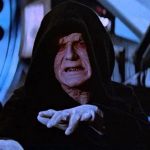 Movies and TV
Movies and TV  Movies and TV
Movies and TV  Creepy
Creepy 10 Eerie & Mysterious Ghosts of the Pacific Coast
 Weird Stuff
Weird Stuff 10 Typos That Accidentally Changed History
 History
History 10 Times Trickery Won Battles
 Technology
Technology 10 Awesome Upgrades to Common Household Items
 Misconceptions
Misconceptions 10 Hilarious (and Totally Wrong) Misconceptions About Childbirth
 Weird Stuff
Weird Stuff 10 Warning Labels That Exist Because Someone Actually Tried It
 Health
Health Ten Confounding New Inventions from the World of Biomedicine
 Creepy
Creepy 10 Death Superstitions That Will Give You the Creeps
 Movies and TV
Movies and TV 10 Movies That Get Elite Jobs Right, According to Experts
 Movies and TV
Movies and TV 10 Most Realistic Medical TV Shows of All Time
 Creepy
Creepy 10 Eerie & Mysterious Ghosts of the Pacific Coast
 Weird Stuff
Weird Stuff 10 Typos That Accidentally Changed History
Who's Behind Listverse?

Jamie Frater
Head Editor
Jamie founded Listverse due to an insatiable desire to share fascinating, obscure, and bizarre facts. He has been a guest speaker on numerous national radio and television stations and is a five time published author.
More About Us History
History 10 Times Trickery Won Battles
 Technology
Technology 10 Awesome Upgrades to Common Household Items
 Misconceptions
Misconceptions 10 Hilarious (and Totally Wrong) Misconceptions About Childbirth
 Weird Stuff
Weird Stuff 10 Warning Labels That Exist Because Someone Actually Tried It
 Health
Health Ten Confounding New Inventions from the World of Biomedicine
 Creepy
Creepy 10 Death Superstitions That Will Give You the Creeps
 Movies and TV
Movies and TV 10 Movies That Get Elite Jobs Right, According to Experts
Ten Iconic Movie Soundtracks That Defined a Genre
Since the dawn of the silver screen, people have argued over the best movie soundtracks of all time. Now and then, a movie comes out that seems to capture a moment in cultural history. The 1970 movie Woodstock was a pivotal cinematic release for the U.S. hippie movement of the late ’60s. Likewise, 1983’s Style Wars summed up the burgeoning graffiti and B-boy scene found in downtown New York.
But for this list, we have decided to focus on motion pictures over documentaries. Ten feature films that, along with their soundtracks, perfectly evoke an era of music. Here are ten brilliantly realized movies that came to define a genre.
Related: Top 10 Crazy And Unconventional Music Genres
10 Quadrophenia (1979)
The Who is widely considered to have written some of the greatest rock operas of all time. Although Quadrophenia did not hit the silver screen until 1979, it remains the archetypal movie for the British mod movement of the mid-1960s. Pete Townsend and Co. first released Quadrophenia as a studio album in 1973, and six years later, director Franc Roddam brought their vision vividly to life.
Sex Pistols frontman John Lydon (aka Johnny Rotten) was initially in the running for the lead role, but for some reason, the notorious rabble-rouser was unable to get the insurance. In the end, Phil Daniels was cast as the main character. He plays the loveable rogue Jimmy, a hedonistic young Londoner whose scooter gang is often found brawling with local bikers.
Decades after its release, the movie is now viewed as a cult classic.[1]
9 Ladies and Gentlemen, the Fabulous Stains (1982)
Many directors have attempted to capture the reckless abandon and anarchic energy of the punk era, but none have pulled it off with quite as much panache as Lou Adler. Unlike the makers of Quadrophenia, Adler managed to find room for two Sex Pistols members in his movie. Paul Cook and Steve Jones appear alongside Ray Winston and The Clash’s Paul Simonon as the confrontational British punk band The Looters.
The Looters embark on a tour of the United States, accompanied by aged glam-rock has-beens The Metal Corpses and proto-riot grrrls The Fabulous Stains, who proudly state that they “do not put out.” The soundtrack is almost exclusively made up of tracks by the fictional bands, and it encapsulates the age of glue-sniffing and safety-pin piercings in a way no movie had done before—and none has managed since.[2]
8 Kidulthood (2006)
The birth of grime music was a key milestone in British cultural history. The genre first emerged around the start of the millennium, and within a few years, it had captured people’s imaginations across the country. It was around that time that the first British hood movies started to appear. Of course, the UK was no stranger to gangster flicks. Directors like Guy Ritchie had brought white-collar London crime to a global audience. But it was Bullet Boy and Kidulthood that captured the reality of poverty in inner-city London and displayed it on the big screen.
Described as “the definitive UK hood movie,” Kidulthood was a pivotal moment for grime music and youth culture. Again, it followed the violence and hedonism of Britain’s free-spirited teens, all based around one day in West London. The movie is renowned for its aggressive, high-energy soundtrack, featuring some of the breakout stars of the nascent grime scene.[3]
One song in particular, “Pow” by Lethal Bizzle, would inspire such lunacy on the dancefloor that nightclub owners had to ban DJs from playing it.[4]
7 Super Fly (1972)
If Kidulthood was the era-defining hood movie for mid-2000s London, then Super Fly was the same but for early-1970s New York. The movie came out amidst the Blaxploitation boom that emerged following major victories for the civil rights movement. Gordon Park released one of the first great movies of the period: Shaft, whose theme song is almost as iconic as Super Fly’s. But it was his son, Gordon Parks Jr., who directed this seminal piece of African-American cinema.
Critics praised Super Fly for many reasons: its stylish costumes, its daring cinematography, its nuanced critique of the American dream. But it was Curtis Mayfield who stole the show. His soundtrack combined soul, funk, R&B, and jazz in a way that was completely revolutionary at the time. When the album was reissued in 2002, the sleeve notes read: “In a way, Superfly is the black Sgt. Pepper’s.”[5]
6 Akira (1988)
Japan is known for its wild, boundary-pushing approach to electronic music. Few captured that experimental spirit quite like the makers of Akira. The story first appeared as manga in 1982, describing a post-apocalyptic Tokyo rife with corrupt politicians and deranged scientists. Director Katsuhiro Otomo brought the tale to the silver screen, creating a cyber-punk masterpiece that is said to have inspired everything from The Matrix to Kanye West.
Otomo entrusted the score to Geinoh Yamashirogumi—an avant-garde music collective with over a hundred members. As well as creating the soundtrack for Akira, the group is known for its pioneering use of non-Western tuning in synthesized music.[6]
5 La Planète Sauvage/Fantastic Planet (1973)
On the subject of pioneering works of cinema, it would be remiss not to mention La Planète Sauvage. Although it, like Akira, is a cartoon, the movie acts as a vibrant capsule for the psychedelic and prog-rock scene of early-1970s France. The acid-trip visuals created by René Laloux and Roland Topor have been described as something out of a nightmare, drawing comparisons to Salvador Dalí and Terry Gilliam.
One of the movie’s standout features is the jazz-inspired soundtrack of composer Alain Goraguer. The cosmic animation first came out in 1973 and was awarded the prestigious Grand Prix at that year’s Cannes Film Festival.[7]
4 Human Traffic (1999)
The release of Human Traffic was a pivotal moment in the growth of the British rave scene. Danny Boyle’s 1996 movie Trainspotting had briefly touched on areas of Scotland’s nightclub counter-culture, but Human Traffic was a movie with strobe lights and party drugs seared into its veins.
Director Justin Kerrigan crafted a singular vision, taking the audience from the first few rounds at a traditional English boozer into the drug-addled euphoria of a ’90s nightclub. Pete Tong and Carl Cox, renowned British DJs, both pop up in cameo roles, and the soundtrack acts as a mixtape of some of the era’s defining club classics. Fatboy Slim, Orbit, and Underworld (whose music was also featured in Trainspotting) all make an appearance before the credits roll. Although several similar movies followed in its wake, none quite possessed the same raw energy as Human Traffic. It is a testament to the power of the movie that, over twenty years later, festival-goers are still screaming its catchphrases across the mud-trodden fields of northern England.[8]
3 Belly (1998)
The 1990s were a golden age for hip-hop cinema. Movies like Menace II Society, Boyz n the Hood, and Juice all narrowly missed out on a place on this list. But when it comes to African-American culture, there is one man whose visuals came to define the decade more than any other: Hype Williams.
Hype Williams is one of the most iconic music video directors of any era, but the ’90s were his golden period. Throughout the decade, his work with the likes of Notorious B.I.G., Missy Elliott, and Busta Rhymes was on heavy rotation across the music channels. Toward the start of the millennium, Williams decided it was time to create a movie about the New York projects that raised him. Enlisting a cast of hip-hop royalty, including Nas and DMX, as the two lead roles, Williams created what is still considered one of the greatest U.S. movies in history. A considerable part of that status comes from the soundtrack, which features some of the most eminent performers of the time, including Jay-Z, D’Angelo, and Ja Rule.[9]
2 24 Hour Party People (2002)
The British city of Manchester is renowned for its musical heritage. From Joy Division to The Smiths and from The Stone Roses to Oasis, that strange corner of England is thrumming with talent—past and present. For almost twenty years, from the punk movement of the mid-to-late-1970s through to the raves that lit up the early-1990s, music mogul Tony Wilson was at the cutting edge of the Manchester scene.
24 Hour Party People is a fitting homage to Wilson and to the city’s cultural lineage. Every bit as rough-edged and rebellious as the music itself, Michael Winterbottom’s 2002 biopic serves a vibrant depiction of a time and place that is now ingrained in musical history. The soundtrack bristles with some of the era’s best-remembered artists. And while the role of Wilson is taken by Steve Coogan, most famous for playing Alan Partridge, the real Tony Wilson does appear in a brief cameo, as do members of The Stone Roses, the Happy Mondays, and one of the most notorious figures in musical history, Mark E. Smith from The Fall.[10]
1 The Harder They Come (1972)
It is nigh on impossible to chart the history of reggae without mentioning Jimmy Cliff. The Harder They Come, the movie where he starred and performed the theme tune, was instrumental in bringing Jamaican culture to a global audience. Now a classic of Jamaican cinema, the ’70s gangster flick features Cliff as Ivan Martin, a budding musician who becomes mired in a life of crime.
Most striking of all is the soundtrack. The action of The Harder They Come is backed by a compilation of top-tier talent from the Caribbean island that includes The Maytals, Desmond Dekker, and, of course, Jimmy Cliff himself. Songs like “You Can Get It If You Really Want It” and the title track are still instantly recognizable all these years later.[11]








